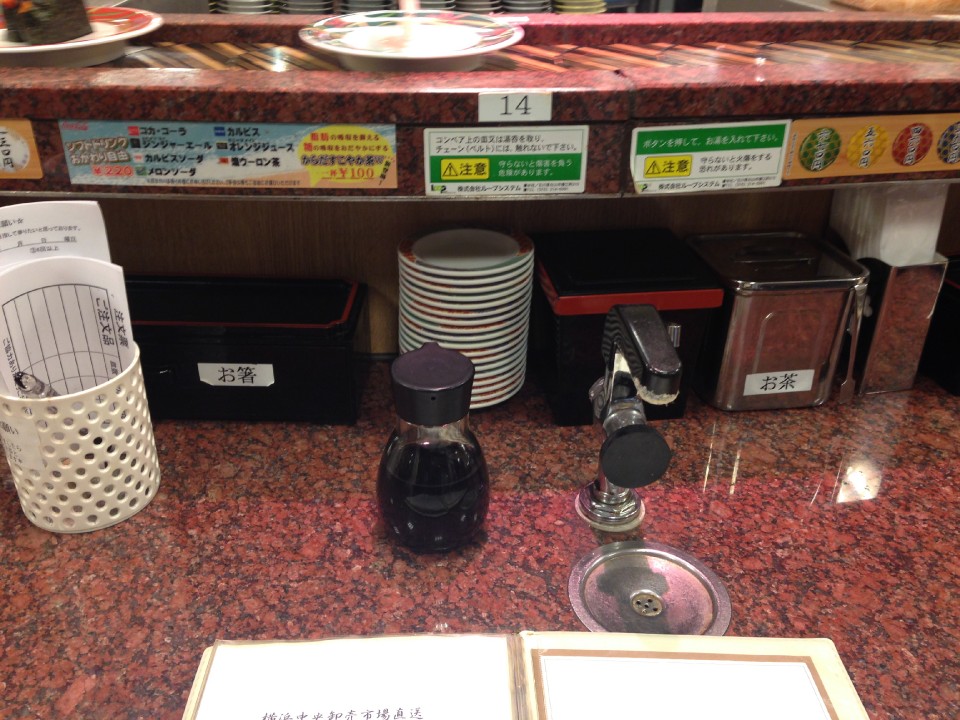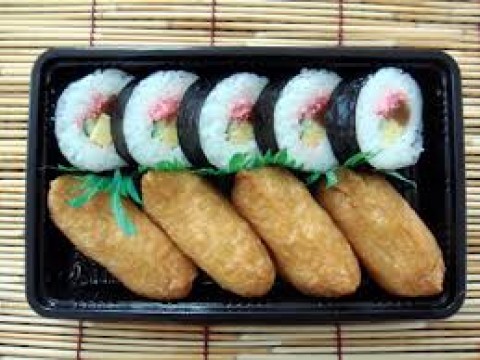5 Tips On How to Eat Sushi in Japan
Isn't That Green Powder Wasabi? How NOT to make the Mistake of Green Tea Powder in your Soy Sauce.
As we sat at the Sushi Bar in Tokyo’s Shinagawa Station we were so excited about what would emerge over the glass separation from the Sushi Shokunin (Chef). We watched as he deftly clumped slightly sweetened and vinegar-kissed white rice into little Nigiri Gunkans (literally translated at “Pressed Warships”) of seafood delight. As an aside, there are different types of sushi. One is Gunkan or “Warship shape” because of the white rice underpinning, a touch of wasabi in the middle and then the yummy raw fish laid on top. Another is Temaki “Hand Rolled” style with your rice and fish combo rolled inside a larger piece of dried seaweed. Temaki kind of look like sushi ice cream cones and sometimes come standing up. Sweet!
For both types, it is fine to use your fingers to dip them gently in the soy sauce dish you’ll find upon arrival. Take a little dish and put a touch of soy sauce there to prepare for the upcoming Sushi spread. Actually, some sushi types don't require soy sauce at all so before dunking your freshly made sushi in your pond of yummy soy sauce, you might want to catch the eye of your sushi chef and motion with your sushi towards the waiting liquid as if saying “To Sauce or Not to Sauce…that is the Question”. He will nod yes or adamantly shake “No” if the delicacy is already prepared in exactly the way it should enter your mouth, as is. Make sure to follow his lead since he knows better than we do which sauce or condiment goes best with which sushi. I would also suggest only drinking tea when eating sushi since that will better prep your taste buds for all the sensations soon to be running up and down your tongue.
Now, here is the tricky part. Very few (almost none) of the Sushi joints in Tokyo or anywhere in Japan have clearly marked signage about sauces and condiments available to the eager patron. Due to this lack of instruction as well as various sushi styles becoming popular overseas, there are some pretty interesting mistakes to be made if you aren’t sure about what is set before you on that baffling counter.
So here are some tips and hints for how to handle the part of your sushi experience that happens on your side of the counter.
1. Tea is often in powder form and bright green just like….Wasabi! If your not careful you will end up with green tea flavored Sushi.
Unbeknownst to me, while we innocently watched the Sushi Shokunin put together gunkans for our gastronomic delight, my best friend was eagerly mixing powdered green tea with his soy sauce. He let me know that wasabi in the States sometimes comes in powdered form, so for all your State Siders and other sushi fans from around the world, Wasabi wont be in powder form pretty much anywhere here. The green tea at the sushi bar is either in a tea bag or in powder form or served by the waitress. Look for the green tea as soon as you are seated and note you can have as much tea as you like for free. It is the super healthy choice so Go Green Whenever You Can.
2. Various towels and wipes keep you and the counter clean.
Using a shared table wiping rag to wipe your mouth is pretty distasteful so here’s how to tell which is which.
You will receive a white “oshibori” washcloth towel for your hands and mouth when you sit down. It will be passed directly to you in a wrapped or unwrapped state. Or, you might see them piled prettily nearby, wrapped in plastic for you to take for yourself. These are all perfectly clean and hygienic and Japanese eateries are very careful to make sure you will be the first one to use the one you receive. In a nutshell, there is no sharing of o-shibori. On the other hand, regarding the pink or blue cloths you see folded near the tray return area or towards the far side of the counter that no one passes your way? These are the SHARED post-meal wipe-up towels for the table or counter. My mother did not know this and proceeded to use one as a napkin and wipe her mouth during eating to the utter horror of everyone (most particularly me) in the restaurant. Trust me, I mentioned it, but ahhhh how often to mothers truly take the advice of their kids?
3. Pink Ginger for Here and There only
Use the pink ginger slices in the silver box sparingly…just a bit here and there. Imagine putting a gob of butter on everything you eat, because eating too much ginger is kind of like that. It is an accent more than a prerequisite addition to your sushi
4. Wasabi is already in the Sushi
It is rare that you will require Wasabi for your soy sauce. Just say “nashi” if you want no Wasabi, “Sukuname” if you want less than usual, “Futsuu” if you want the regular amount and “Oome” if you want more than usual. The Shokunin will put it right in perfectly under your fish on the gunkan or inside the seaweed wrap. Tastes much better that way anyway, so leave it to the pro.
5. Chopsticks and Secret Toothpick Nook.
There will usually be a brown chopstick length box somewhere near your seat. Open it up and Voila! Your chopsticks!! Remember never to put your used chopsticks back in this box, you can leave them right on top of your dish after you eat (horizontally on the dish please). Also, it is proper to hold your sushi in the chopsticks so that the top of the sushi will touch the soy sauce as you dip. If you put rice in first, it will break apart before you get it to your mouth and this is referred to as gucha gucha “messy” in Japan. Also, there is a cute little toothpick nook next to the chopstick section. It is proper to cover your mouth as you toothpick and ladies are welcome to do it too, just maybe lower your head and don't make it to obvious (from one toothpick loving girl to another).
So just a quick review:
1. Wasabi will not be in powdered form so try not to mix green tea in with your soy sauce.
2. Shared towels that were just used to wipe up another patron’s hand prints or drippings from the counter are best used for cleaning up THE COUNTER after you have eaten there…not for wiping your mouth during the mea.
3. Pink Ginger is like gobs of butter. Just a taste is enough to add flavor to your sushi.
4. Wasabi is already in the sushi so no need to add more. Enjoy the taste of the fish and rice combination without overpowering it with spicy wasabi.
5. The chopstick box hides a secret toothpick nook for your after meal refreshment.
Have fun with your Sushi Experience in Japan!

Former Deep Japan Writer


















